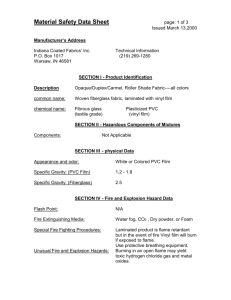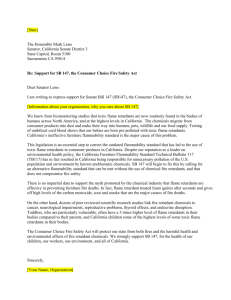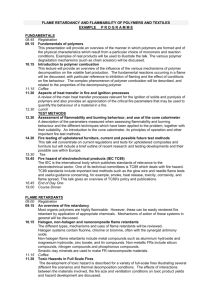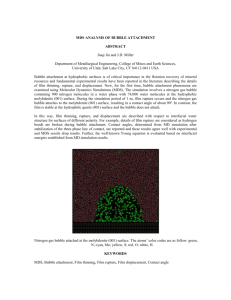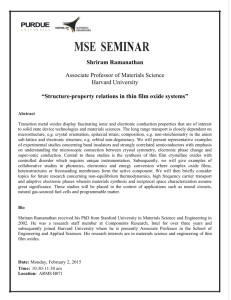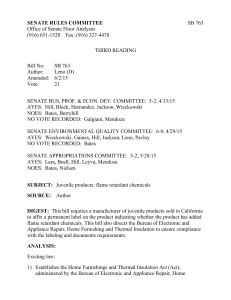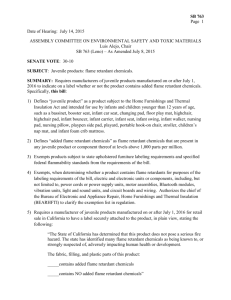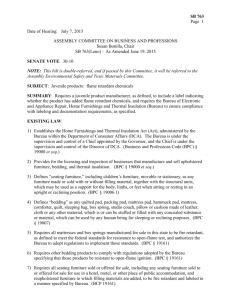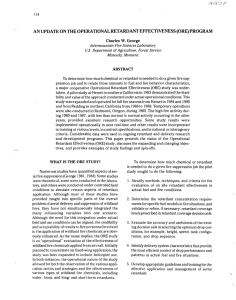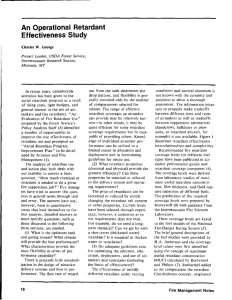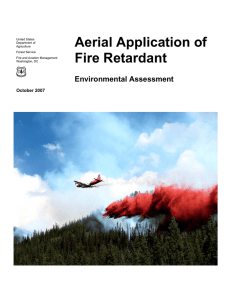Flame Retardant Bubble cont`d - Kyana Packaging and Industrial
advertisement
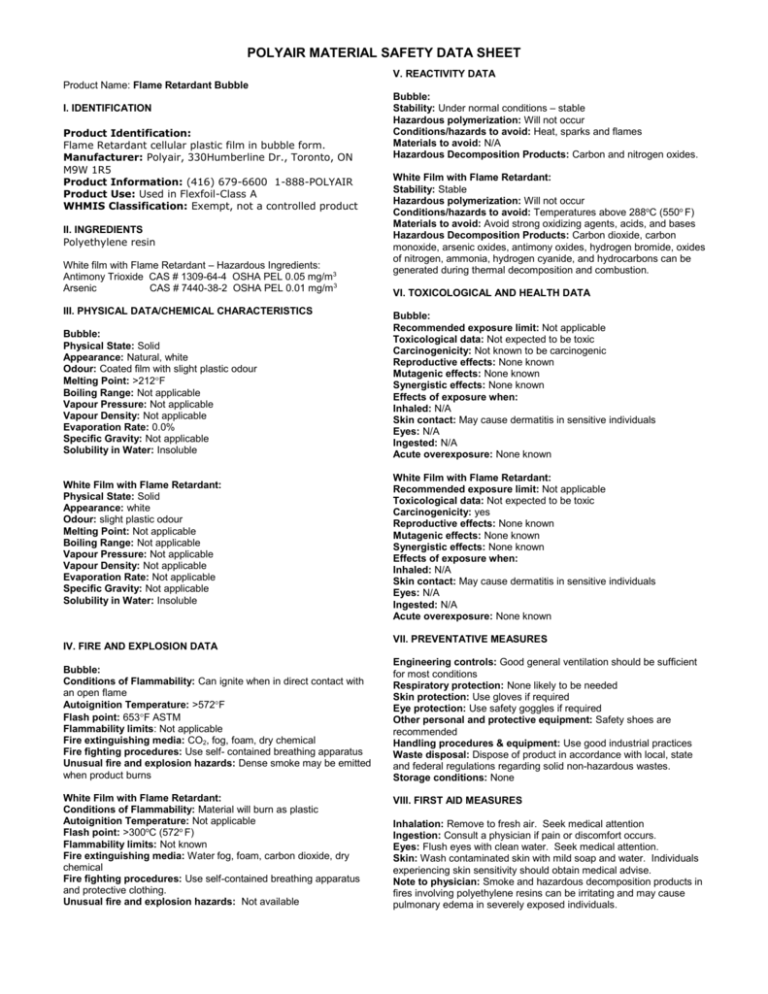
POLYAIR MATERIAL SAFETY DATA SHEET V. REACTIVITY DATA Product Name: Flame Retardant Bubble I. IDENTIFICATION Product Identification: Flame Retardant cellular plastic film in bubble form. Manufacturer: Polyair, 330Humberline Dr., Toronto, ON M9W 1R5 Product Information: (416) 679-6600 1-888-POLYAIR Product Use: Used in Flexfoil-Class A WHMIS Classification: Exempt, not a controlled product II. INGREDIENTS Polyethylene resin White film with Flame Retardant – Hazardous Ingredients: Antimony Trioxide CAS # 1309-64-4 OSHA PEL 0.05 mg/m3 Arsenic CAS # 7440-38-2 OSHA PEL 0.01 mg/m3 III. PHYSICAL DATA/CHEMICAL CHARACTERISTICS Bubble: Physical State: Solid Appearance: Natural, white Odour: Coated film with slight plastic odour Melting Point: >212F Boiling Range: Not applicable Vapour Pressure: Not applicable Vapour Density: Not applicable Evaporation Rate: 0.0% Specific Gravity: Not applicable Solubility in Water: Insoluble White Film with Flame Retardant: Physical State: Solid Appearance: white Odour: slight plastic odour Melting Point: Not applicable Boiling Range: Not applicable Vapour Pressure: Not applicable Vapour Density: Not applicable Evaporation Rate: Not applicable Specific Gravity: Not applicable Solubility in Water: Insoluble IV. FIRE AND EXPLOSION DATA Bubble: Conditions of Flammability: Can ignite when in direct contact with an open flame Autoignition Temperature: >572F Flash point: 653F ASTM Flammability limits: Not applicable Fire extinguishing media: CO2, fog, foam, dry chemical Fire fighting procedures: Use self- contained breathing apparatus Unusual fire and explosion hazards: Dense smoke may be emitted when product burns White Film with Flame Retardant: Conditions of Flammability: Material will burn as plastic Autoignition Temperature: Not applicable Flash point: >300oC (572o F) Flammability limits: Not known Fire extinguishing media: Water fog, foam, carbon dioxide, dry chemical Fire fighting procedures: Use self-contained breathing apparatus and protective clothing. Unusual fire and explosion hazards: Not available Bubble: Stability: Under normal conditions – stable Hazardous polymerization: Will not occur Conditions/hazards to avoid: Heat, sparks and flames Materials to avoid: N/A Hazardous Decomposition Products: Carbon and nitrogen oxides. White Film with Flame Retardant: Stability: Stable Hazardous polymerization: Will not occur Conditions/hazards to avoid: Temperatures above 288oC (550o F) Materials to avoid: Avoid strong oxidizing agents, acids, and bases Hazardous Decomposition Products: Carbon dioxide, carbon monoxide, arsenic oxides, antimony oxides, hydrogen bromide, oxides of nitrogen, ammonia, hydrogen cyanide, and hydrocarbons can be generated during thermal decomposition and combustion. VI. TOXICOLOGICAL AND HEALTH DATA Bubble: Recommended exposure limit: Not applicable Toxicological data: Not expected to be toxic Carcinogenicity: Not known to be carcinogenic Reproductive effects: None known Mutagenic effects: None known Synergistic effects: None known Effects of exposure when: Inhaled: N/A Skin contact: May cause dermatitis in sensitive individuals Eyes: N/A Ingested: N/A Acute overexposure: None known White Film with Flame Retardant: Recommended exposure limit: Not applicable Toxicological data: Not expected to be toxic Carcinogenicity: yes Reproductive effects: None known Mutagenic effects: None known Synergistic effects: None known Effects of exposure when: Inhaled: N/A Skin contact: May cause dermatitis in sensitive individuals Eyes: N/A Ingested: N/A Acute overexposure: None known VII. PREVENTATIVE MEASURES Engineering controls: Good general ventilation should be sufficient for most conditions Respiratory protection: None likely to be needed Skin protection: Use gloves if required Eye protection: Use safety goggles if required Other personal and protective equipment: Safety shoes are recommended Handling procedures & equipment: Use good industrial practices Waste disposal: Dispose of product in accordance with local, state and federal regulations regarding solid non-hazardous wastes. Storage conditions: None VIII. FIRST AID MEASURES Inhalation: Remove to fresh air. Seek medical attention Ingestion: Consult a physician if pain or discomfort occurs. Eyes: Flush eyes with clean water. Seek medical attention. Skin: Wash contaminated skin with mild soap and water. Individuals experiencing skin sensitivity should obtain medical advise. Note to physician: Smoke and hazardous decomposition products in fires involving polyethylene resins can be irritating and may cause pulmonary edema in severely exposed individuals. POLYAIR MATERIAL SAFETY DATA SHEET Flame Retardant Bubble cont’d IX. SPILL OR LEAK PROCEDURES Bubble/ White film: In case material is released/spilled, treat/handle as inert material. Disposal method: Dispose as would with any basically inert material, in accordance with State, Federal & Local regulations. X. SPECIAL PROTECTION INFORMATION Ventilation/Local exhaust: Good general ventilation should be sufficient for most conditions. Local exhaust ventilation may be necessary for some operations. Ventilation/Mechanical (General): Not applicable Respiratory Protection: None likely to be needed. Precautions to be taken in handling/storing: No special hazards anticipated under conditions normally encountered in storage, handling, processing, use, or disposal. MSDS prepared by: Quality Assurance Department Rev: August 2007 While the information contained in this document is believed to be reliable as of the date of issue, such information is general in nature. The material described here can be hazardous if not handled, stored and processed properly. POLYAIR must rely on the user to use the information supplied here, together with any other information to develop appropriate work and use practices.
